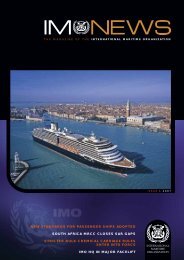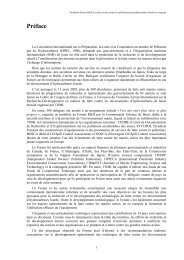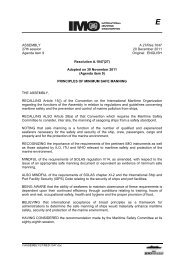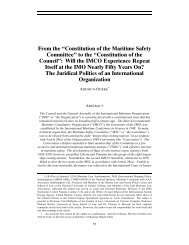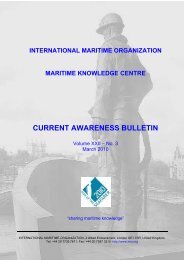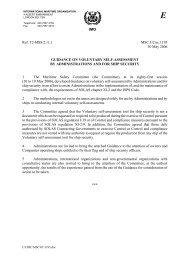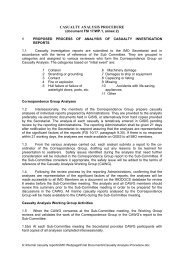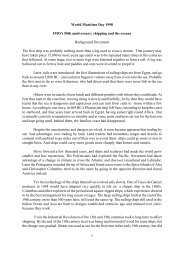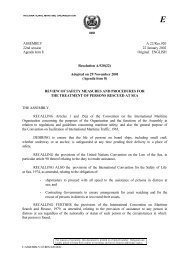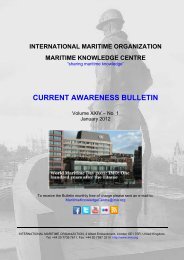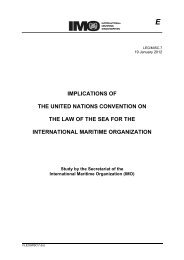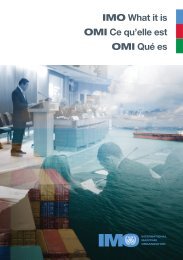Radioactive Waste Disposal at Sea: Public Ideas ... - IMO
Radioactive Waste Disposal at Sea: Public Ideas ... - IMO
Radioactive Waste Disposal at Sea: Public Ideas ... - IMO
Create successful ePaper yourself
Turn your PDF publications into a flip-book with our unique Google optimized e-Paper software.
64 Chapter 4<br />
marine environment and “may, for this purpose, formul<strong>at</strong>e, present, or support<br />
specific proposals in the United N<strong>at</strong>ions and other competent intern<strong>at</strong>ional<br />
organiz<strong>at</strong>ions for the development of appropri<strong>at</strong>e intern<strong>at</strong>ional<br />
rules and regul<strong>at</strong>ions in support of the policy of this Act.” 15<br />
Two days l<strong>at</strong>er, EPA Administr<strong>at</strong>or William Ruckelshaus submitted to<br />
the Sen<strong>at</strong>e a draft of a bill for n<strong>at</strong>ional legisl<strong>at</strong>ion. The bill was part of a<br />
comprehensive and wide-ranging action program th<strong>at</strong> built on the 23 legisl<strong>at</strong>ive<br />
proposals and the 14 acts to clean up air and w<strong>at</strong>er submitted to<br />
the Congress the year before. “Upon introduction in the Congress it was<br />
clear,” wrote one of the staff members to the hearings, “th<strong>at</strong> the issues<br />
would be primarily jurisdictional, not substantive: a political demand for<br />
the legisl<strong>at</strong>ion was evident; the regul<strong>at</strong>ory techniques chosen were acceptable<br />
without objection.” (Miller 1973, p. 59)<br />
The Scientific Basis of Ocean Dumping Regul<strong>at</strong>ion<br />
Ocean scientists presume th<strong>at</strong> the oceans have an identifiable assimil<strong>at</strong>ive<br />
capacity. 16 This concept relies on the capacity of the oceans to absorb and<br />
neutralize pollutants. It follows th<strong>at</strong> as long as this assimil<strong>at</strong>ive capacity is<br />
not exceeded the marine environment will clean itself. Consequently, pollution<br />
occurs when a certain marine capacity is exposed to pollutants th<strong>at</strong><br />
exceed the upper level or capacity of assimil<strong>at</strong>ion of contamin<strong>at</strong>ion. In this<br />
definition room is given to a certain legitim<strong>at</strong>e use of the waste disposal<br />
capacity of the oceans, as long as the regener<strong>at</strong>ion of the ocean resources is<br />
not prevented. It is therefore necessary to consider specific conditions—<br />
such as mixing capacity, turnover time (it takes, for example, 25–40 years<br />
for the w<strong>at</strong>er in the Baltic <strong>Sea</strong> to be renewed), str<strong>at</strong>ific<strong>at</strong>ion of w<strong>at</strong>er, temper<strong>at</strong>ures,<br />
and level of biological activity—when defining the assimil<strong>at</strong>ive<br />
capacity of a certain region. As used by professionals, the word contamin<strong>at</strong>ion<br />
signifies wh<strong>at</strong> is less than clean but not quite polluted. 17<br />
In the early 1970s, knowledge of environmental effects of ocean dumping<br />
was <strong>at</strong> best rudimentary. In 1971, R. B. Clark, British scientist and editor<br />
of Marine Pollution Bulletin, described the st<strong>at</strong>e of the art in marine<br />
pollution research as follows: “Most knowledge of the biological consequences<br />
of marine pollution is derived from studies in temper<strong>at</strong>e w<strong>at</strong>ers.<br />
Inform<strong>at</strong>ion about these environments is woefully inadequ<strong>at</strong>e, but it is encyclopedic<br />
compared with wh<strong>at</strong> we know about even the basic ecology of



